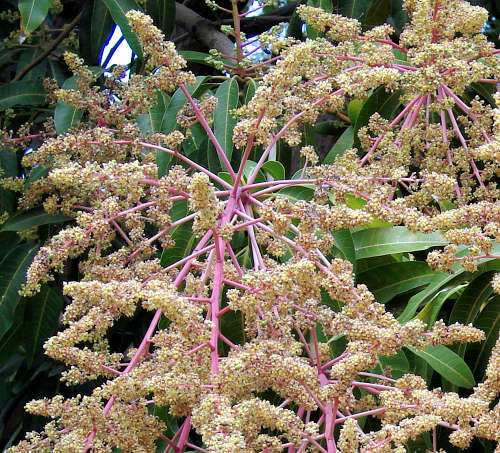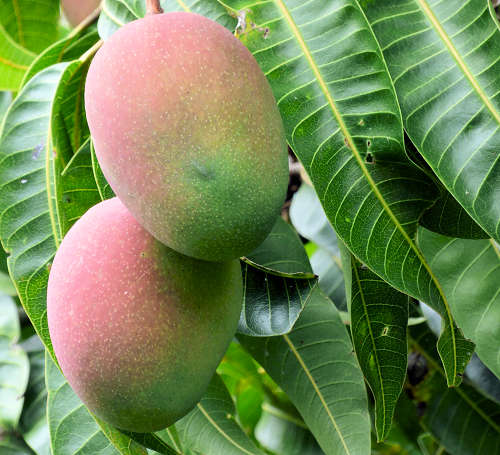Growing Mangoes:
Mangifera indica
Back to Fruit, Berries and Nuts
Botanical Overview
A member of the Cashew and Sumac family (Anacardiaceae), the Mangifera genus contains 10 species. Mangoes are the most prominent member of the genus, and more than 500 cultivars are grown around the world.
Description
Form: Tree.
Lifespan: Up to 300 productive years.
Leaf retention: Evergreen.
Growth rate: Rapid.
Mature Size: 10-60' (3-18m) high and 5-30' (1.5-9m)
wide.
Flowers:
White to pink, five petals, tiny, clustered at the end of shoots, fragrant.
Bloom:
Late fall or winter, depending on cultivar and microclimate. Mature trees tend to
alternate between heavy bloom years and light bloom years. Pruning excess blooms
in heavy years may reduce this alternation.
Self-fruitful: Yes.
Years before fruiting:
5-8 from seed, 3-5 with grafted rootstock.
Fruit:
Large, with yellow, orange, red, and/or green skin, pale yellow to orange, sweet,
ripe pulp. The fruit contains a single flat, oblong pit which does not separate
easily from the pulp. The pit contains a seed which is either monoembryonic or
polyembryonic (a seed composed of multiple segments, each of which grows a seedling).
Months for fruit to ripen:
3-6. Mangoes are ripe when they turn color, when the flower end widens, or when they
start to fall from the tree. Ripe mangoes will snap off the stem with a slight pull.
Mangoes continue to ripen after being picked, even when green. Some mango cultivars
should be harvested green and ripened indoors to produce the best flavor.
Storage after harvest:
Mangoes harvested green will ripen in 10-21 days at room temperature. Mangoes can be
refrigerated up to 2 weeks, but only after they are ripe, or chill injury results.
Leaves: Lance-shaped, orange-pink when young,
rapidly changing to a dark glossy red, then dark green with maturity.
Stems: No thorns.
Roots:
This tree has a taproot growing up to 20' (6m) deep, and wide surface feeder roots.
It is often grafted onto a cold-hardy rootstock.
Cultivars of Note (fiberless):
These trees can be grown in a container or trimmed 6-10' (1.8-3m) high. They are considered to have superior flavor and are monoembryonic unless noted otherwise.
These trees can be grown in a container or trimmed 6-10' (1.8-3m) high. They are considered to have superior flavor and are monoembryonic unless noted otherwise.
'Carrie' – Florida origin, 10-15' (3-4.5m)
high tree, June-July harvest, 10-12oz (0.28-0.34kg) fruit is very soft when ripe and
bruises easily.
'Cogshall' – Florida, tree can be kept
to 6' (1.8m) high, June-July harvest, 10-16oz (0.28-0.45kg) fruit.
'Fairchild' – Panama, tree can be kept
to 8' (2.4m) high, June-July harvest, 10oz (0.28kg) fruit.
'Florigon' – Florida, 10-12' (3-3.7m) high
tree, May-July harvest, 6-12oz (0.17-0.34kg) fruit, polyembryonic.
'Ice Cream' – Trinidad & Tobago,
tree can be kept to 6' (1.8m) high, June-July harvest, mango-sorbet flavor, 8oz (0.23kg)
fruit.
'Lancetilla' – Honduras, tree can be
kept 10' (3m) high, August-September harvest, up to 5lb (2.3kg) fruit.
'Mallika' – India, 10-12' (3-3.7m) high tree,
June-July harvest when mature green, ripens 10-21 days later, 10-18oz (0.28-1.36kg) fruit.
'Manilita' – Mexico, tree can be kept
to 7' (2.1m) high, March-April harvest, 9oz (0.25kg) fruit, polyembryonic.
'Nam Doc Mai' – Thailand, tree can be
kept to 10' (3m) high, June-July harvest, 12-20oz (0.28-0.57kg) fruit, variable yields year
to year, best harvested early mature-firm rather than mature-soft, polyembryonic.
Wildlife:
The flowers attract flies, thrips, and wasps for pollination, rarely bees. The fruit
attracts birds, fruit bats, small mammals and deer.
Toxic / Danger:
All parts, including fruit skin, can cause dermatitis and anaphylaxis in susceptible
individuals. Peeled fruit is safe to eat. Avoid skin contact with sap when picking
fruit.
Origin:
Eastern India and Myanmar. Cultivated for more than 4000 years.


Cultivation and Uses
USDA hardiness zones:
9b-15. Young trees are killed below 30°F (-1.1C), older trees are killed below 26°F
(-3.3°C). Flowers and small fruit are heavily damaged below 40°F (4.4°C).
All trees receive some damage at 32°F (0°C).
Low wattage incandescent bulbs inside a frost cloth tent can be used to protect smaller trees
from winter freezes. Remove the frost cloth when the temperature gets above freezing.
Chill hours: None.
Heat tolerant:
Healthy, irrigated trees can withstand 118°F (47.8°C). Leaves may turn yellow at high
temperatures but green up in cooler weather.
Drought tolerant:
Yes, but with loss of fruit crop.
Sun:
In regions with hot summers, avoid reflected heat.
This tree may do better with afternoon shade during the hottest six months of the year.
Planting:
In regions with the possibility of winter freezes, position the tree in the hottest part of
the yard where cold air does not accumulate.
Plant on top of a mound if necessary to ensure proper soil drainage. Mango trees do not tolerate flooding.
Place the tree far enough away from any structure to accommodate the tree's mature size. Some dwarf cultivars can be grown in containers and/or in greenhouses.
Plant on top of a mound if necessary to ensure proper soil drainage. Mango trees do not tolerate flooding.
Place the tree far enough away from any structure to accommodate the tree's mature size. Some dwarf cultivars can be grown in containers and/or in greenhouses.
Soil:
Well draining, deep, low to moderate organic content, pH 5.6-7.5 (acidic to neutral).
Some mango rootstocks may provide mild salt tolerance, others do not.
Fertilize:
Apply organic fertilizer every other month mid-winter to mid-summer. Add plant micronutrients
to irrigation water at the same time. Avoid chemical fertilizers.
Water after becoming established:
Deep water twice a week in the hottest part of
summer. In winter, deep water once a month.
Mulch:
Apply organic mulch inside the drip line, and 1' (0.3m) away from the trunk, to retain soil
moisture and protect from winter freezes.
Prune:
Trim in late winter. Wear gloves to avoid skin contact with sap. In the first few years,
trim the tree to develop a strong structure. Trimming off the top of the main trunk and the
top branches will keep the tree at a given height without harm. It may lower production
for a year.
Litter:
Low. Do not burn clippings or litter because the sap is poisonous.
Propagation:
Mangoes are often grafted onto hardy, dwarfing rootstock, most successfully in warm weather.
They can be grown from seed, although only polyembryonic seeds breed true. Even so, one of
the polyembryonic seeds will be a fertilized one, less vigorous than the others, not
breeding true, and should be discarded. The other seeds in a polyembryonic set are clones.
Mango seeds do not survive freezing.
Uses:
Edible fruit, ornamental, shade.
Comments
These trees do well in regions without freezes or where frost lasts only one
or two hours.
Do you have additional information or a different experience for these plants that you would like to share? Email info@GardenOracle.com. All contributions are welcome and appreciated.
Do you have additional information or a different experience for these plants that you would like to share? Email info@GardenOracle.com. All contributions are welcome and appreciated.
Latest update: January, 2024
© 2008-2025 by GardenOracle.com

